- | Academic & Student Programs Academic & Student Programs
- | Housing Housing
- | Policy Briefs Policy Briefs
- |
California Can Improve Housing and Transit by Preempting Local Ordinances

Introduction
The housing market of coastal California is a good example of a market where growing demand and stagnant supply are leading to high and rising prices. From San Diego to Sonoma County, a strong economy, rich culture, and natural beauty attract Americans and immigrants from all age groups. At the same time, tight restrictions on building new housing at either urban centers or the exurban fringe limit the availability of new housing. When tight supply meets burgeoning demand, prices rise.
In a bid to allow for more new housing and thus slow or even reverse the ongoing growth in prices, State Senator Scott Wiener has introduced a bill, SB 827, in the California State Senate that would preempt some local restrictions on housing construction near transit stations and frequent bus routes. The bill, in its present form, is an appropriate use of the state’s preemptive power and is likely to slow or reverse the growth in housing costs. State law already includes a requirement for cities to permit new housing to meet targets for new supply, but the law has no teeth. SB 827, in turn, would more effectively limit localities’ ability to restrict housing supply.
In this article, we discuss the California housing market, the principled case for preempting municipal ordinances in California’s institutional environment, the specifics of SB 827, and the likely effects and limits of passing SB 827 into law.
California’s Housing Market
California contains 10 of the 11 most-expensive metropolitan areas in the country. The San Jose area has an eye-popping median single-family home value of $1,275,800. The median single-family home in the San Diego area (the 11th highest nationally) is worth half that, which is still about 50 percent more than the median value in the expensive New York, Washington, or Denver metro areas.
For renters, the picture is no better. Median apartment rent is above $3,000 per month in the San Jose and San Francisco areas. Eight more California metro areas round out the nation’s 12 costliest rental markets, along with New York and Boston. Statewide, monthly apartment rent rose $87 in 2017, compared to $25 nationwide.
Strict and time-consuming land use regulations and ordinances are a major source of inflexibility in California’s housing supply. The Wharton Residential Land Use Regulatory Index measures several dimensions of land use regulation based on a 2005 survey of local governments. Figures 1 and 2 compare California’s land use approval processes with the rest of the United States.
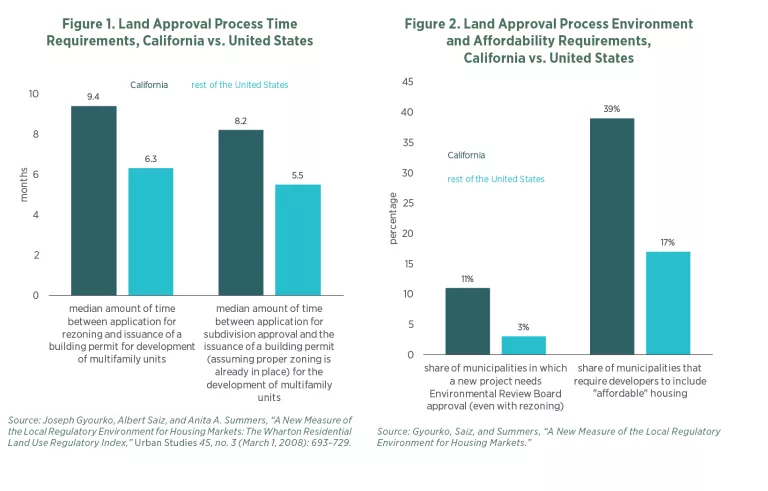
As a consequence of land use restrictions, California metropolitan areas’ housing supply and populations have grown less than high-demand cities elsewhere. Although the housing growth champions of the 2010s are spacious, low-regulation cities like Austin (+19 percent), many areas that share California’s topographical barriers to growth have nonetheless added more housing in the last seven years than California metros, as figure 3 illustrates.
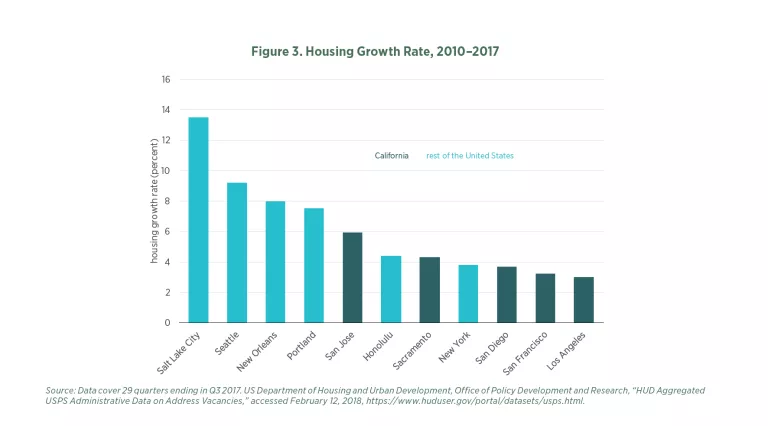
California’s small coastal cities are even more exclusive: the metropolitan areas that make up Ventura, Monterey, Santa Cruz, Sonoma, and Napa counties each added less than 3 percent to their housing stocks during the same time period.
Despite the demand for housing and infamous road congestion, many California transit stations are surrounded by low-density retail centers, suburban homes, and parking lots. The potential gains from the enactment of SB 827 in terms of both housing supply and increasing transit use are largest around low-density suburban stations, such as the area around Bay Fair Station on the Bay Area Rapid Transit (BART) system (see figure 4 on page 4).
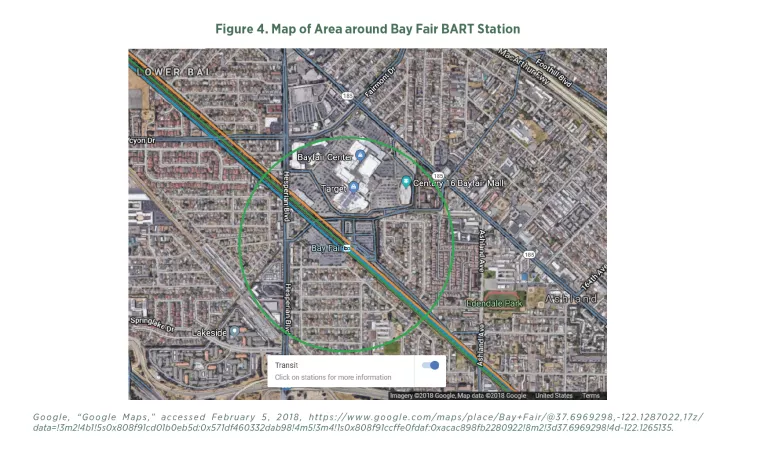
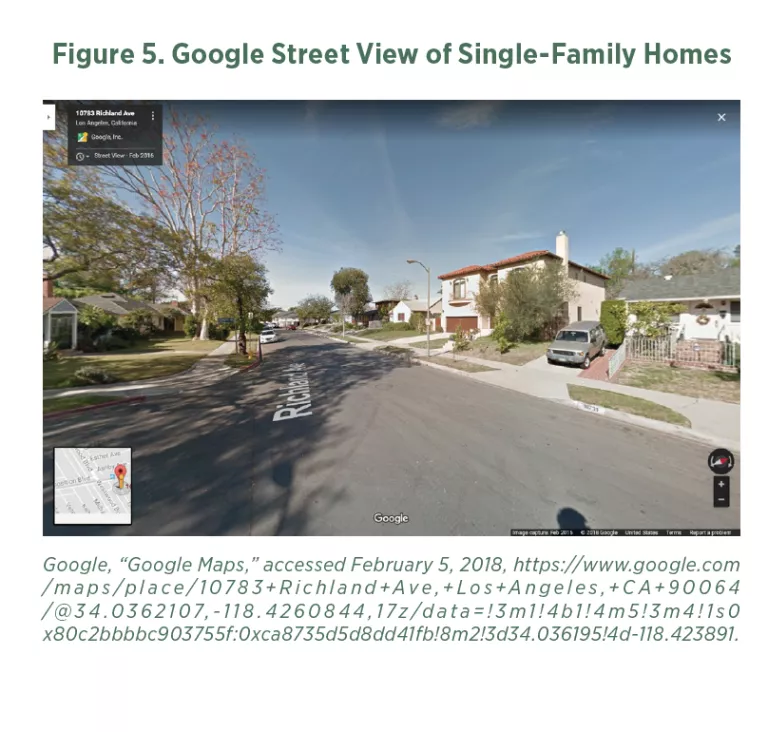
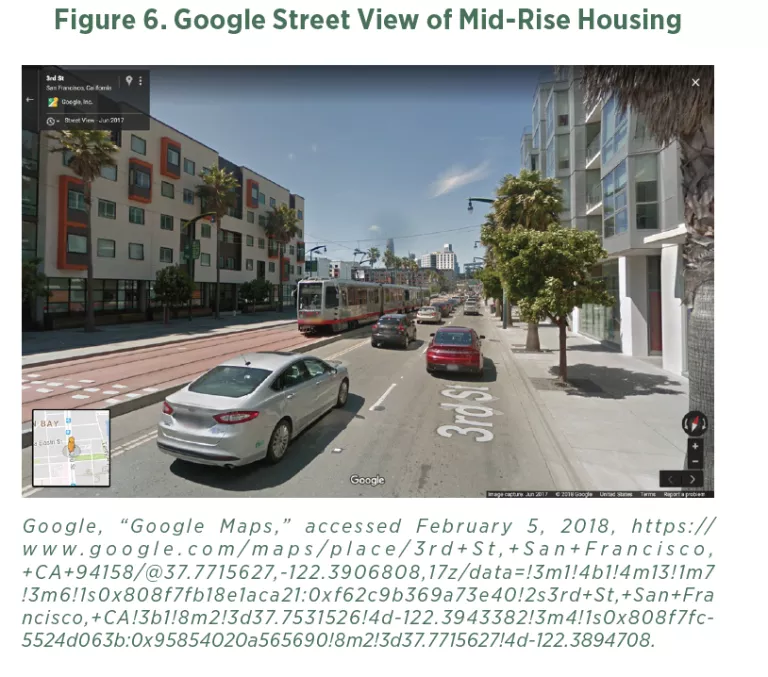
California cities offer amenities and economic opportunities that are attracting new residents from across the country and around the world. To accommodate a growing population, the state needs a new regulatory approach, one that allows new growth and offers clearly delineated rules to minimize bureaucratic delays.
California’s Role in Preempting Local Land Use Rules
SB 827 would implement state preemption of local land use regulation near public transit. In other words, the state would be setting limits on the extent to which municipalities can restrict development. Preemption of local land use regulations is a legal recourse of state governments because municipalities are “creatures of their states.” The State of California should have a role to play in restraining local land use regulations for three key reasons: protecting individual property rights, facilitating economic growth, and supporting efficient use of state transportation investments.
Individual Property Rights
Economist Michael Farren has argued that, in general, rulemaking should rest at the most local level of government possible, but that higher level governments should use their authority to ensure that lower levels of government do not violate individual rights.
This principled case for the preemption embodied by SB 827 rests on the state’s duty to protect property owners’ rights to determine the best use of their land. The bill would allow more development options than current local rules do, in turn increasing access to high-demand areas and allowing more people to take advantage of existing transit investments.
Economic Growth
Aside from protecting individual rights, easing land use regulation in California would improve conditions for economic growth. The density of people, firms, and industries within cities results in agglomeration benefits; living in cities makes those residents more productive by giving them an opportunity to learn from one another and creating an environment that supports innovation.
Kyle Herkenhoff, Lee Ohanian, and Edward Prescott used a macroeconomic model to conclude that “Deregulating only California to its 1980 level and leaving the land-use regulation level of all other states unchanged, raises [national] output, investment, [productivity], and consumption by about 1.5%, and increases California’s population by about 6.0 million workers.” While SB 827 does not go as far as this simulation in deregulation, it is nevertheless a policy step toward promoting economic growth.
When local jurisdictions permit new housing construction, they get only a fraction of the resulting benefits (such as economic growth and lower regional housing prices) while absorbing most of the costs. Consequently, local governments constrain new developments at the expense of regional welfare gains. State action provides a coordinating mechanism for citizens to share the costs as well as the benefits of growth.
Efficient Transportation Investments
The role that California plays in funding transportation provides an additional nexus for state preemption of local land use rules. Last year, the state allocated about $400 million to transit projects. When local governments don’t permit housing development near these transit investments, buses and expensive rail projects benefit a smaller number of riders—and require larger subsidies—than if denser development were allowed near transit corridors.
Los Angeles’ most recent Exposition Line extension, for example, connects neighborhoods that are largely zoned for single family development from Santa Monica to Culver City. The line covers less than a quarter of its operating expenses with ticket sales, in part because under current zoning, dense housing development is prohibited, so few people are able to take advantage of it. With liberal zoning near transit, transit fares could cover a larger portion of its expenses, freeing taxpayers from having to subsidize it so heavily.
Housing growth along the Caltrain corridor from San Jose to San Francisco has been more than twice the Bay Area average since 2010, allowing Caltrain to almost double its ridership, lower its per-passenger operating subsidy from $3.80 to $1.00, and cut its taxpayer subsidy in half. Even Californians who never use transit still benefit from efficient private development around transit stations.
SB 827’s Requirements
SB 827 would set limits on local housing regulations through “transit-rich housing bonuses.” These would apply to housing projects that sit within half a mile of a major transit stop or within a quarter mile of a high-quality transit corridor.
The bill would preempt the following local regulations on new housing for projects that meet the bonus requirements:
- Limits on residential density,
- Parking requirements, and
- Design standards that restrict residential density beyond building code requirements.
The bill would also preempt local height limits based on the following criteria:
- Eighty-five feet would be the lowest allowable minimum height limit for projects within one-quarter mile of a high-quality transit corridor or within one block of a major transit stop, except for parcels facing streets that are less than 45 feet wide. In these cases, the lowest allowable height limit would be 55 feet.
- For projects that are within a half mile of a major transit stop, the bill would preempt height limits below 55 feet, except when the parcel is facing a street that is less than 45 feet wide, in which case the lowest allowable height limit would be 45 feet.
Today, many of California’s desirable, transit-accessible neighborhoods are zoned for only low-density residential uses. This bill would make it legal for property owners to sell these homes to developers who would replace them with mid-rise residential buildings that would allow more people to access these locations.
All of the preemptions in SB 827 would reduce current barriers to housing supply that result in high and rising house prices in many California markets. Height limits and density restrictions limit supply directly by preventing developers from taking advantage of high-value land with apartment buildings that allow many households to live in prime locations. Minimum lot size and minimum unit size requirements are the quintessential “snob zoning” rules that communities have used to outlaw inexpensive housing in their jurisdictions, preventing lower-income households from moving in.
Rules that require open space rather than allowing developers to build to parcels’ lot lines interact with height limits to restrict the potential supply of housing within a local jurisdiction. Similarly, while parking requirements may not seem to limit housing supply directly, they mandate that space is dedicated to car storage rather than alternative uses. When developers respond to parking requirements by providing surface lots, less land is available for development. In high-cost locations, developers may choose to provide very expensive above-ground or underground garages. In Los Angeles, one estimate finds that parking requirements contribute over $100,000 to the cost of each new apartment unit. Under SB 827, some apartments would be built with less parking, resulting in lower-cost options for those who are willing to trade fewer parking spots for cheaper rent.
SB 827 would establish limits on local regulations, but it would not set any minimum sizes on new buildings or establish rules requiring new developments to meet minimum density standards. It would simply transfer some development decisions from local governments to developers.
Institutional Interactions
Preempting local ordinances that limit citizens’ property rights and worsen economic outcomes is certainly within the state’s purview, but it should be done carefully. As written, SB 827 could lead to unintended responses from local policymakers who are looking for ways to circumvent the bill’s preemption.
Potential for Municipal Workarounds
Local governments will likely respond to a reduction in their power to implement exclusionary zoning and attempt to find creative ways to limit the effects of SB 827 without running directly afoul of the law. To prevent the construction of new market-rate affordable housing, municipalities could pursue historical designations or shut down bus routes.
While SB 827 prevents zoning code design standards that drive up housing costs, it leaves open the door for local regulators to put costly requirements in their building codes—a platinum toilet mandate, for example. Or a municipality could mandate that 100 percent of new apartments near transit be leased or sold at below-market rates, ensuring that only nonprofit housing is built. By increasing the cost of development, requirements that developers provide below-market-rate housing decreases the potential for SB 827 to increase housing supply. If localities scramble to update zoning codes, there is a risk of more mid-project rule changes that currently bedevil construction projects.
Analysis from the San Francisco Planning Department points out that, as written, SB 827 leaves local review processes in place. Policymakers who wish to severely restrict new development in their jurisdiction could simply allow the queue of proposed projects to accumulate without accelerating the rate at which they approve new development.
SB 827 could lead to rapid municipal rulemaking by local policymakers who are seeking to avoid its intended outcome. In turn, this could create significant policy confusion and an unnecessary rush by developers to secure permits before new local rules take effect. SB 827 should include temporary relief from local responses in the defined transit-rich zones. Any project that applies for a permit within the next five years should be eligible to use January 1, 2018, zoning and building codes as well as the SB 827 preemptions. This exemption would remove the incentive for localities to respond too rapidly in either trying to sabotage or accommodate SB 827 and provide builders with precious clarity as they proceed.
Environmental Protection
The California Environmental Quality Act (CEQA) offers neighbors the chance to tie up any unpopular development project in court. Under CEQA’s “private right of action,” anyone can file a lawsuit to halt a project, public or private, that has allegedly failed to consider some adverse outcome, such as congestion or air quality. Jennifer Hernandez, David Friedman, and Stephanie DeHerrera note that “any party can file a CEQA lawsuit, even if it has no environmental purpose. For example, a competitor can file a CEQA lawsuit to delay or derail a competing project.” Despite the name, CEQA is used in urban California to stop the very infrastructure, infill, and apartment construction that would make California a more environmentally friendly place.
Since transit-oriented infill development is far more environmentally friendly than the alternatives, exempting construction in transit-rich areas from CEQA challenges would be an effective measure in the efforts to control housing costs. These projects would still have to abide by environmental rules, but enforcement would be left in the hands of the state, as it is elsewhere in the United States. Without CEQA, residents would still have recourse against true harms under existing nuisance laws.
Conclusion
Ahead of SB 827’s first conference hearing, Senator Wiener has introduced amendments that would exempt some parcels from the bill’s preemptions and add relocation benefits for tenants affected by demolition. If the bill moves forward in the political process, it will likely continue to evolve. Changes that reduce the amount of land where local zoning rules are preempted will also reduce potential new housing supply that puts downward pressure on prices. However, as long as the bill still upzones substantial amounts of land near transit stations, it can be expected to increase housing supply growth and improve affordability.
States have an important role to play in protecting individual rights from local restrictions. When states preempt local land use regulations, they also facilitate competition between local jurisdictions, promote economic growth, and, as in the case of SB 827, reduce transit subsidies.
SB 827 is an attempt by state policymakers to rein in local land-use regulations. Because California residents suffer the pains of high and rising housing prices induced by regulatory constraints on supply, state preemption has the potential to create opportunities for increased access to housing in several markets.
Localities could escape preemption by putting new design standards in their building codes, excluding themselves from public transit routes, implementing historic preservation or affordability requirements, or encouraging lawsuits under the guise of environmentalism. Failing to anticipate these workarounds will limit the chances that the bill achieves its intended goal of increasing access to housing in transit-rich locations.
To speak with a scholar or learn more on this topic, visit our contact page.

